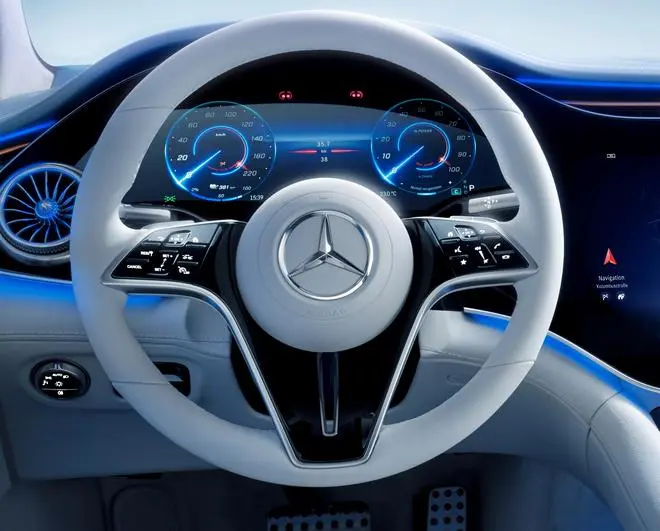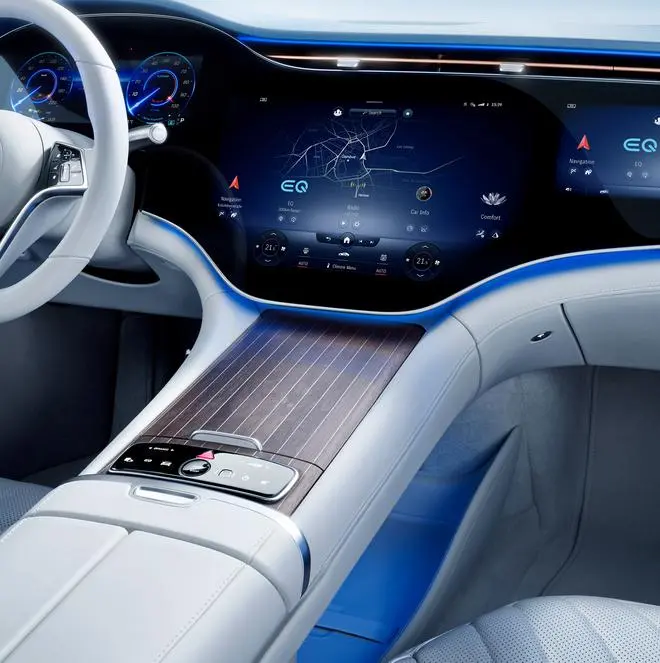Amid the other vehicles on the crowded streets of Stuttgart, Germany, the EQS, Mercedes-Benz’s relatively new electric flagship sedan, sticks out without trying too hard. Not because its design is a break-away in a forced, unconventional sort of rebellious streak, but because it is effortlessly futuristic while staying within the three-pointed star’s embrace. It also bears the signatures of an EQ but carves its own luxurious niche. The EQS’s sinuous, extremely aerodynamic exterior surfaces could be construed as that of an aggressively new ICE model but get behind the wheel and you would be excused for thinking it is a cockpit more apt for Captain Kirk!
Within the next few weeks, one of the EQS variants will be launched and be available for pre-orders at your nearest Mercedes dealership. A trip to Stuttgart earlier this month to test drive this electric saloon was then a necessary addition to my calendar.
Design
While the EQS is Merc’s electric flagship, it is not exactly the S-Class equivalent in its footprint and positioning. But Mercedes designers and engineers have ensured that the EQS has its own allure. And that starts with its record-breaking aerodynamics. With a coefficient of drag value of 0.20, it is the most aerodynamic production vehicle ever. Its solid glossy black bonnet grille leading onto the headlamps on either side, the connected LED tail-lamps and the flowing lines of the coupe-like body are Mercedes-EQ trademarks. The low front, the cab-forward stance, frameless doors and the sporty silhouette capture the essence of the design’s purpose. And the fact that the joints have been reduced, the panel gaps tightened and roofline has been designed to optimise airflow, while maximising interior space, point to the extreme focus on aerodynamics.
Further, the recessed door handles, the smooth, closed underbody and side air-vents at the rear boost the EQS’s aerodynamic performance. The bonnet design is meant to aid uninterrupted flow of air over the steeply raked roofline and its edges overlap the wings without the need for a working hinge to open it. This then means that there is no ‘frunk’ in the EQS and you will not be able to open the bonnet (will need some explaining to hotel security staff). The EQS is Mercedes-EQ’s first vehicle built on a completely new, modular all-electric architecture. The others have been converted platforms originally meant for ICE (internal combustion engine) vehicles. A dedicated EV platform delivers a lot more freedom to both designers and engineers in creating all-electrics with internal components that are specifically optimised for performance.
What you see in these pictures taken during the drive in and out of Stuttgart are of the EQS 580 4MATIC. However, MB India plans to first introduce the EQS AMG - the first electric AMG. There are likely to be a few design differences between the two model variants.
Cabin
If the exterior design of the EQS wasn’t ‘wow’ enough, the cabin is jaw-droppingly futuristic and is sure to leave you stunned. The MBUX Hyperscreen on the dashboard is unmissable; and of all the floating, under-lit touch panels from the German brand this is by far the biggest and the most complex. A lot of electrics and their oversized screens seem overblown, gaudy even in some cases, but the Hyperscreen’s magical integration and elegant curved 3D construction will leave even automotive purists happy and curious in equal measure. The hyperscreen takes up all of the dashboard fascia; prompting observations as to whether “it is a car with a TV in it or a TV around which a car has been built”. It is more than four and half feet wide and is actually multiple screens that have been cleverly integrated into one, with a user interface that is intuitive and includes independent controls and a customisable section of the screen for the front passenger.
The MBUX Hyperscreen on the dashboard is unmissable | Photo Credit: Mercedes-Benz AG - Global Commun

The MBUX Hyperscreen is surrounded only by a thin silver shadow frame, a vent band and a narrow leather frame. Speaking of the materials used, Merc designers have given the EQS an ultra-modern air, but retained the traditional materials that deliver the message of luxury in their vehicle cabins. So, there is aluminium, wood veneer panels and lacquered trims inserts that have been combined in the EQS’s cabin. The outer aircon vents on either side of the Hyperscreen are a slightly different take on the turbine design that has become a Merc standard. The appearance of the screens can be individualised with three display styles (discreet, sporty, classic) and three modes (Navigation, Assistance, Service). The Hyperscreen is an optional fitment if one was to choose the lower trim variants or the single electric motor versions. But, while the imported AMG 53 may not get the screen, Merc India is likely to bring the locally assembled 580 4MATIC later and in this the screen should be available here.
The rest of the EQS’s cabin features also sport their own unique design elements, though none are as special as the Hyperscreen. But, Merc hasn’t attempted reinventing the wheel and so some of them like the seats are only focused on delivering comfort and a high perceived luxury feel. Doors and their centre panels emerge from behind the Hyperscreen to form a semi-circular arc. A surface-mounted modular body floats like a sideboard in front of the door panel and houses all necessary door elements such as armrest, door module, pull handle and map pocket. The wide seats in my test mule had soft, rounded side bolsters; but the AMG line will feature slim monolithic sports seats. One of the cabin’s other highlights is the 15-speaker, 710-watt Burmester surround sound system, which while reproducing audio tracks with remarkable clarity, also plays back pre-recorded driving sounds to recreate the effect of driving an ICE car. The driver can choose from three different soundscapes and the output also varies depending on driving mode selected, speed and amount of throttle input. I personally didn’t quite enjoy the rather ‘electronic-y’ output, which is also delivered at standstill like in an idling ICE vehicle.
Performance
At the heart of the EQS’s electric powertrain is the 107.8kWh battery pack located under the floor of the vehicle. The battery holds a total of 216 lithium-ion cells within 12 modules. The EQS is said to be capable of delivering a driving range of up to 770kms. It is offered in some markets with a single electric motor, but what will land on our shores will sport two electric motors - one each on both the front and rear axles. Like the name suggests, my test mule EQS 580 4MATIC’s two motors delivered a total of 385kW (about 518hp) of peak power and a peak torque of 855Nm. With those impressive numbers, the EQS 580 accelerates from standstill to 100kmph in 4.3 seconds and can reach an electronically limited 210kmph. The Mercedes-AMG EQS 53 4MATIC that will be launched first in India will have a combined output of 650hp and 950Nm. It’ll do the dash to 100kmph in 3.8 seconds and reach a top speed of 220kmph. With the Dynamic Plus package the performance could be even higher.
It is on the highway and the autobahn that I get to experience the EQS 580 electric powertrain’s dollops of torque and their impact. My guess is that the AMG will even be quicker and the acceleration Gs must feel addictive if one can experience them within legal speed limits. The vehicle gets complex power electronics and combines a ridiculous number of sensors for it to be able to deliver performance that is clean and sedate while driving in town, and clean and blistering on the highway. The electric powertrain system offers both a coasting mode (no regen or charge loss) and a varying number of regenerative braking modes, including one-pedal driving. However, I feel that the EQS’s braking performance and style may take some getting used to. What seems like a lack of bite at the brake pedal is apparently due to the staged regen and deceleration that has been programmed into the system.
Despite its large footprint, the EQS is surprisingly easy to manoeuvre even in tight city traffic, thanks largely to the availability of rear axle steering. Interestingly, while the vehicle is offered with a rear axle turning assistance of 4.5 degrees, an increase upto 10 degrees can be purchased through an over-the-air update. The digital economy is truly evolving.
Bottom Line
The battery of the EQS can be charged via an AC wall socket and will take over 10 hours to charge. It can also handle fast DC supercharging upto 200kW, which can deliver 300kms worth of charge in 30 minutes. The air suspension in the EQS can be adjusted to deliver a firmer, more agile set up or for a more comfort-oriented ride feel. Drive modes selected will also deliver preloaded settings. One can expect the suspension to deliver a performance bias focus on Indian road conditions.

The EQS will deliver all the MBUX intuitiveness and functions that is currently being experienced by S-Class owners, including features like Energising Comfort. The amount of legroom in the cabin is certainly not in the same league as the S-Class, though the EQS is still surprisingly roomy including generous amounts of headroom even for tall passengers.
The EQS sports multiple other digital innovations and tech breakthroughs, including a number of autonomous driving aids. incidentally, it is also manufactured at ‘Factory 56’ one of the most advanced automobile production facilities of Mercedes-Benz in Stuttgart. The Mercedes-AMG EQS 53 4MATIC will be launched next month and the EQS 580 4MATIC will arrive before the festive season. Expect prices to range from ₹1.75 crore to ₹2.2 crore.




Comments
Comments have to be in English, and in full sentences. They cannot be abusive or personal. Please abide by our community guidelines for posting your comments.
We have migrated to a new commenting platform. If you are already a registered user of TheHindu Businessline and logged in, you may continue to engage with our articles. If you do not have an account please register and login to post comments. Users can access their older comments by logging into their accounts on Vuukle.